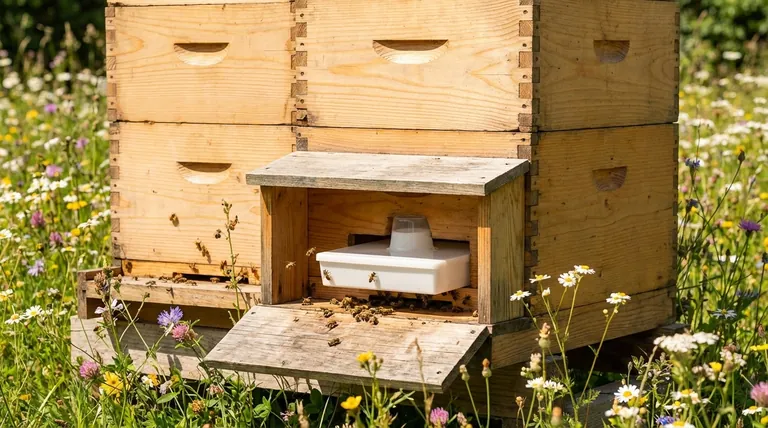By a significant margin, the most common beehive used around the world is the Langstroth hive. First patented in 1852, its revolutionary design consists of vertically stacked rectangular boxes, known as "supers," which contain removable frames for the bees to build their comb on. Its dominance, particularly in North America and Australia, is due to its efficiency, modularity, and the standardization of its components.
While the Langstroth hive is the default choice for commercial operations and most hobbyists, its popularity is a direct result of its design for honey production and ease of management. Understanding why it works reveals that the "best" hive is entirely dependent on the beekeeper's specific goals.

Why the Langstroth Hive Dominates
The Langstroth hive's success isn't an accident; it's based on a fundamental discovery about bee behavior and a brilliantly simple, modular design that leverages it.
The Key Innovation: "Bee Space"
The entire design is built around the precise discovery of "bee space"—a gap of roughly 3/8 of an inch (or 9.5 mm). Lorenzo Langstroth observed that bees will not build comb in a space this size, nor will they seal it with propolis (a resinous glue), instead keeping it as a clear passageway.
By designing his hive with this exact spacing between the frames and the hive walls, he created the first hive with truly removable frames. This allowed beekeepers to inspect the colony for health, disease, and honey stores without destroying the bees' comb.
The Power of Modularity
Langstroth hives are like a set of building blocks. The main components—the hive body (brood box) and the supers (honey boxes)—are simple, stackable boxes.
This modularity allows a beekeeper to expand or contract the hive based on the colony's needs and the season's nectar flow. A strong colony in summer might require several honey supers, while the same colony can be consolidated into a smaller space to survive the winter.
Standardization and Compatibility
The design is largely standardized, coming most commonly in 10-frame or 8-frame versions. This has created a massive ecosystem of compatible equipment.
Whether a beekeeper needs a new frame, a queen excluder, or a feeder, components from different manufacturers are almost always interchangeable. This simplifies purchasing and ensures long-term usability, much like how standardized shipping containers revolutionized global trade.
Understanding the Trade-offs
The Langstroth's focus on production and standardization comes with drawbacks. This has led other hive designs to gain popularity among beekeepers with different priorities.
Langstroth: Efficiency vs. Weight
The primary advantage of the Langstroth is its efficiency for maximizing honey production. The removable frames are also perfectly sized for mechanical honey extractors.
However, its main disadvantage is weight. A deep hive body full of brood, pollen, and honey can weigh over 80 pounds (36 kg), and a shallow honey super can easily exceed 40 pounds (18 kg). This can make hive management a significant physical challenge.
The Top Bar Hive: A "Natural" Alternative
Gaining popularity among hobbyists, the Top Bar Hive is a single, long box with simple wooden bars laid across the top. Bees build their comb down from these bars naturally, without the guidance of pre-made foundation.
This design is considered more "bee-centric" and involves far less heavy lifting, as the beekeeper only ever inspects one bar at a time. However, honey harvesting is more destructive (crush-and-strain method) and yields are typically much lower.
Making the Right Choice for Your Goal
Selecting a hive is the first major decision in a beekeeping journey. The right choice aligns the equipment with your personal philosophy and physical capabilities.
- If your primary focus is maximum honey production and ease of finding equipment: The 8-frame or 10-frame Langstroth hive is the undisputed industry standard.
- If your primary focus is natural beekeeping, minimal heavy lifting, and comb honey: The Top Bar Hive is an excellent choice that offers a different style of management.
Ultimately, understanding the core principles of each design empowers you to choose the hive that best serves both you and your bees.
Summary Table:
| Hive Type | Primary Use | Key Advantage | Key Disadvantage |
|---|---|---|---|
| Langstroth Hive | Commercial & Hobbyist | High honey yield, standardized equipment | Heavy boxes (up to 80 lbs) |
| Top Bar Hive | Natural Beekeeping | Lighter, bee-centric design | Lower honey yield, destructive harvesting |
Ready to equip your apiary with the industry's best?
As a trusted wholesale supplier to commercial apiaries and distributors, HONESTBEE provides the durable, standardized Langstroth equipment you need to maximize your operation's efficiency and honey production. Our high-quality hives, frames, and accessories are built for the demands of professional beekeeping.
Contact our expert team today to discuss your wholesale needs and get a quote.
Visual Guide

Related Products
- HONESTBEE Professional Hive Top Bee Feeder Feeding Solution
- Ergonomic Two Person Foldable Hive Lifter
- Professional Drop-Style Hive Handles for Beekeeping
- Professional Galvanized Hive Strap with Secure Locking Buckle for Beekeeping
- Professional Grade Foldable Beehive Handles
People Also Ask
- How is the plywood floor fitted into the hive-top feeder? Ensure Longevity with a Floating Floor Design
- Do I need an inner cover with a hive top feeder? Optimize Your Hive Setup for Healthy Bees
- Why is a top feeder essential for bees? Ensure Colony Health and Efficiency
- What should be done with feeders and equipment after feeding bees? Essential Steps for Apiary Health
- What features make top feeders a reliable choice for beekeepers? A Guide to Safe, Efficient Hive Nutrition



















